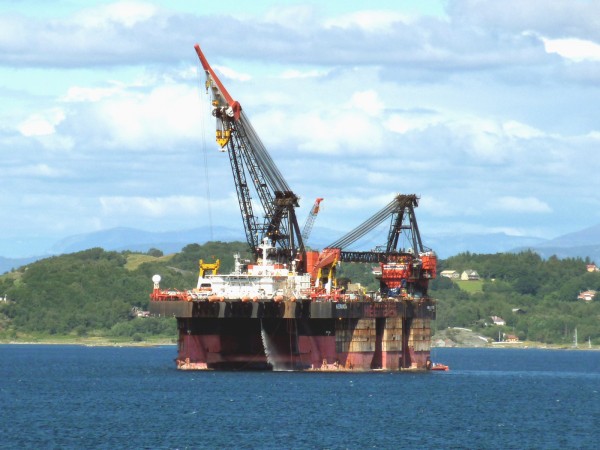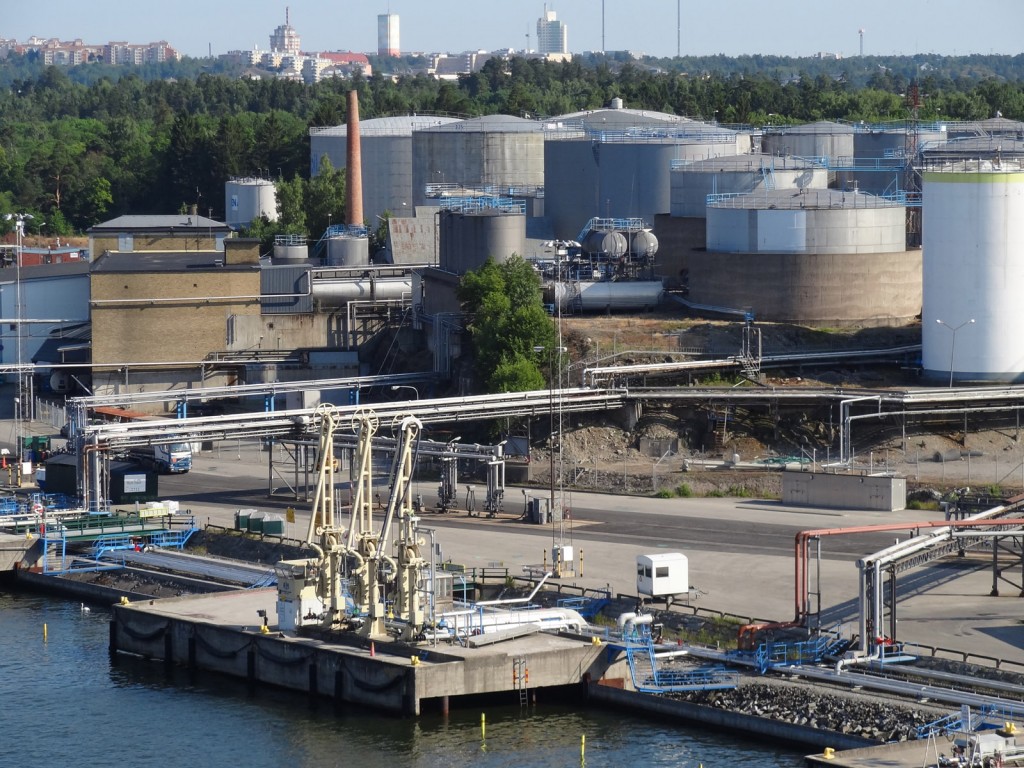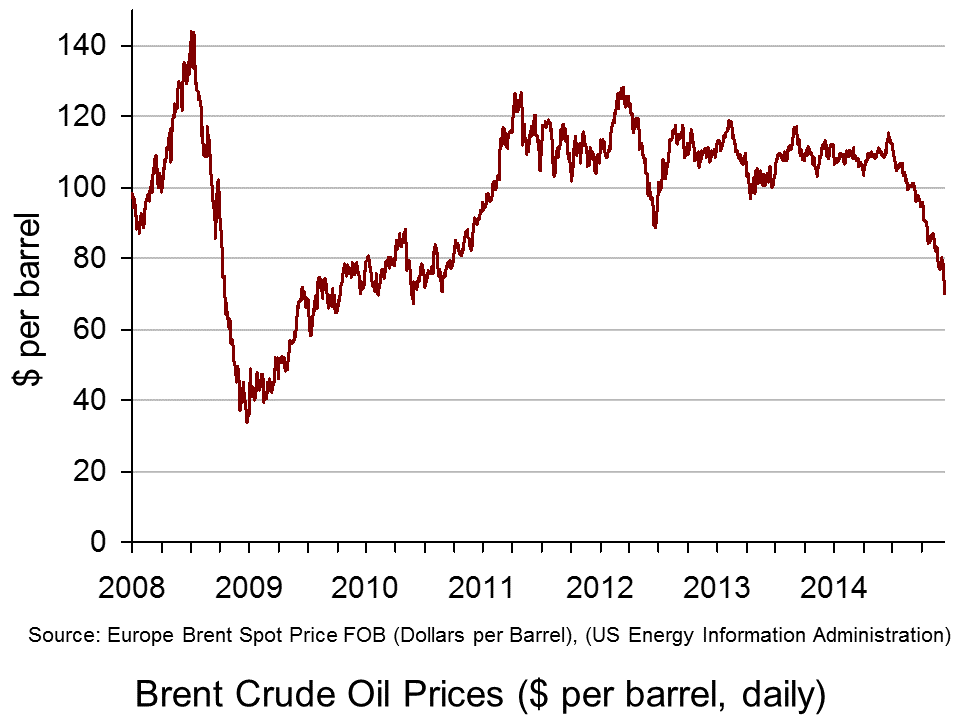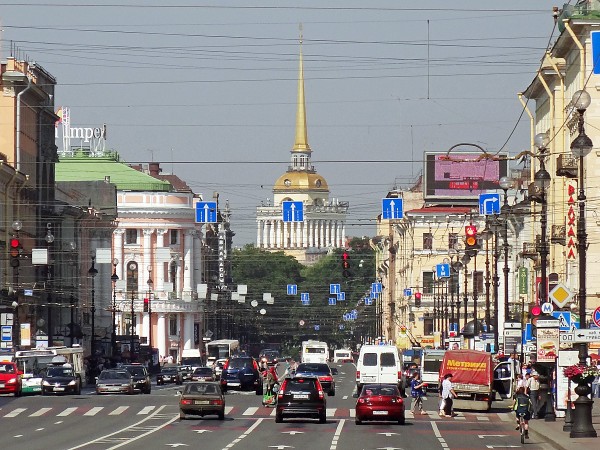 The recent low price of oil has been partly the result of faltering global demand but mainly the result of increased supply from shale oil deposits. The increased supply of shale oil has not been offset by a reduction in OPEC production. Quite the opposite: OPEC has declared that it will not cut back production even if the price of oil were to fall to $30 per barrel.
The recent low price of oil has been partly the result of faltering global demand but mainly the result of increased supply from shale oil deposits. The increased supply of shale oil has not been offset by a reduction in OPEC production. Quite the opposite: OPEC has declared that it will not cut back production even if the price of oil were to fall to $30 per barrel.
We looked at the implications for the global economy in the post, A crude indicator of the economy (Part 2). We also looked at the likely effect on oil prices over the longer term and considered what the long-run supply curve might look like. Here we examine the long-run effect on prices in more detail. In particular, we look at the arguments of two well-known commentators, Jim O’Neill and Anatole Kaletsky, both of whom have articles on the Project Syndicate site. They disagree about what will happen to oil prices and to energy markets more generally in 2015 and beyond.
Jim O’Neill argues that with shale oil production becoming unprofitable at the low prices of late 2014/early 2015, the oil price will rise. He argues that a good indicator of the long-term equilibrium price of oil is the five-year forward price, which is much less subject to speculation and is more reflective of the fundamentals of demand and supply. The five-year forward price is around $80 per barrel – a level to which O’Neill thinks oil prices are heading.
 Anatole Kaletsky disagrees. He sees $50 per barrel as a more likely long-term equilibrium price. He argues that new sources of oil have made the oil market much more competitive. The OPEC cartel no longer has the market power it had from the mid 1970s to the mid 1980s and from the mid 2000s, when surging Chinese demand temporarily created a global oil shortage and strengthened OPEC’s control of prices. Instead, the current situation is more like the period from 1986 to 2004 when North Sea and Alaskan oil development undermined OPEC’s power and made the oil market much more competitive.
Anatole Kaletsky disagrees. He sees $50 per barrel as a more likely long-term equilibrium price. He argues that new sources of oil have made the oil market much more competitive. The OPEC cartel no longer has the market power it had from the mid 1970s to the mid 1980s and from the mid 2000s, when surging Chinese demand temporarily created a global oil shortage and strengthened OPEC’s control of prices. Instead, the current situation is more like the period from 1986 to 2004 when North Sea and Alaskan oil development undermined OPEC’s power and made the oil market much more competitive.
Kaletsky argues that in a competitive market, price will equal the marginal cost of the highest cost producer necessary to balance demand and supply. The highest cost producers in this case are the shale oil producers in the USA. As he says:
Under this competitive logic, the marginal cost of US shale oil would become a ceiling for global oil prices, whereas the costs of relatively remote and marginal conventional oilfields in OPEC and Russia would set a floor. As it happens, estimates of shale-oil production costs are mostly around $50, while marginal conventional oilfields generally break even at around $20. Thus, the trading range in the brave new world of competitive oil should be roughly $20 to $50.
So who is right? Well, we will know in twelve months or more! But, in the meantime, try to use economic analysis to judge the arguments by answering the questions below.
The Price of Oil in 2015 Project Syndicate, Jim O’Neill (7/1/15)
A New Ceiling for Oil Prices Project Syndicate, Anatole Kaletsky (14/1/15)
Questions
- For what reasons might the five-year forward price of oil be (a) a good indicator and (b) a poor indicator of the long-term price of oil?
- Under O’Neill’s analysis, what would the long-term supply curve of oil look like?
- Are shale oil producers price takers? Explain.
- Draw a diagram showing the marginal and average cost curves of a swing shale oil producer. Put values on the vertical axis to demonstrate Kaletsky’s arguments. Also put average and marginal revenue on the diagram and show the amount of profit at the maximum-profit point.
- Why are shale oil producers likely to have much higher long-run average costs than short-run variable costs? How does this affect Kaletsky’s arguments?
- Under Kaletsky’s analysis, what would the long-term supply curve of oil look like?
- Criticise Kaletsky’s arguments from O’Neill’s point of view.
- Criticise O’Neill’s arguments from Kaletsky’s point of view.
- Will OPEC’s policy of not cutting back production help to restore its position of market power?
- Why might the fall in the oil price below $50 in early 2015 represent ‘overshooting’? Why does overshooting often occur in volatile markets?
 Over the past three months oil prices have been falling. From the beginning of September to the end of November Brent Crude has fallen by 30.8%: from $101.2 to a four-year low of $70.0 per barrel (see chart below: click here for a PowerPoint). The fall in price has been the result of changes in demand and supply.
Over the past three months oil prices have been falling. From the beginning of September to the end of November Brent Crude has fallen by 30.8%: from $101.2 to a four-year low of $70.0 per barrel (see chart below: click here for a PowerPoint). The fall in price has been the result of changes in demand and supply.
As the eurozone, Japan, South America and other parts of the world have struggled to recover, so the demand for oil has been depressed. But supply has continued to expand as the USA and Canada have increased shale oil production through fracking.  As far as OPEC is concerned, rather than cutting production, it decided at a meeting on 27 November to maintain the current target of 30 million barrels a day.
As far as OPEC is concerned, rather than cutting production, it decided at a meeting on 27 November to maintain the current target of 30 million barrels a day.
The videos and articles linked below look at these demand and supply factors and what is likely to happen to oil prices over the coming months.
They also look at the winners and losers. Although falling prices are likely in general to benefit oil importing countries and harm oil exporting ones, it is not as simple as that. The lower prices could help boost recovery and that could help to halt the oil price fall and be of benefit to the oil exporting countries. But if prices stay low for long enough, this could lower inflation and even cause deflation (in the sense of falling prices) in many countries. This, in turn, could dampen demand (see the blog post, Deflation danger). This is a particular problem in Japan and the eurozone. Major oil importing developing countries, such as China and India, however, should see a boost to growth from the lower oil prices.
Major oil importing developing countries, such as China and India, however, should see a boost to growth from the lower oil prices.
Some oil exporting countries will be harder hit than others. Russia, in particular, has been badly affected, especially as it is also suffering from the economic sanctions imposed by Western governments in response to the situation in Ukraine. The rouble has fallen by some 32% this year against the US dollar and nearly 23% in the past three months alone.
Then there are the environmental effects. Cheaper oil puts less pressure on companies and governments to invest in renewable sources of energy. And then there are the direct effects on the environment of fracking itself – something increasingly being debated in the UK as well as in the USA and Canada.
Videos
 Oil price at four-year low as Opec meets BBC News, Mark Lobel (27/11/14)
Oil price at four-year low as Opec meets BBC News, Mark Lobel (27/11/14)
 Opec losing control of oil prices due to US fracking BBC News, Nigel Cassidy (4/12/13)
Opec losing control of oil prices due to US fracking BBC News, Nigel Cassidy (4/12/13)
 How the price of oil is set – video explainer The Telegraph, Oliver Duggan (28/11/14)
How the price of oil is set – video explainer The Telegraph, Oliver Duggan (28/11/14)
 How Oil’s Price Plunge Impacts Wall Street Bloomberg TV, Richard Mallinson (28/11/14)
How Oil’s Price Plunge Impacts Wall Street Bloomberg TV, Richard Mallinson (28/11/14)
 Oil Prices Plummet: The Impact on Russia’s Economy Bloomberg TV, Martin Lindstrom (28/11/14)
Oil Prices Plummet: The Impact on Russia’s Economy Bloomberg TV, Martin Lindstrom (28/11/14)
Articles
Oil prices plunge after Opec meeting BBC News (28/11/14)
Crude oil prices extend losses Financial Times, Dave Shellock (28/11/14)
Oil price plunges after Opec split keeps output steady The Guardian, Terry Macalister and Graeme Wearden (27/11/14)
Falling oil prices: Who are the winners and losers? BBC News, Tim Bowler (17/10/14)Hooray for cheap oil BBC News, Robert Peston (1/12/14)
Russian Recession Risk at Record as Oil Price Saps Economy Bloomberg, Andre Tartar and Anna Andrianova (28/11/14)
Rouble falls as oil price hits five-year low BBC News (1/12/14)
Data
Brent Spot Price US Energy Information Administration (select daily, weekly, monthly or annual: can be downloaded to Excel)
Spot exchange rate of Russian rouble against the dollar Bank of England
Questions
- Use a diagram to illustrate the effects of changes in the demand and supply of oil on oil prices.
- How does the price elasticity of demand and supply of oil affect the magnitude of these price changes?
- Explain whether (a) the demand for and (b) the supply of oil are likely to be relatively elastic or relatively inelastic? How are these elasticities likely to change over time?
- Distinguish between the spot price and forward prices of oil? If the three-month forward price is below the spot price, what are the implications of this?
- Analyse who gains and who loses from the recent price falls.
- What are the effects of a falling rouble on the Russian economy?
- What are likely to be the effects of further falls in oil prices on the eurozone economy?
One of the interesting things about the recent recession was the dilemma that it posed for governments. As aggregate demand fell, unemployment rose, incomes fell, which reduced demand further and so national output began to decline. Obviously there were many other factors contributing to this decline, in particular the housing market, but the long and the short of it is, aggregate demand was falling. With the AD curve shifting inwards, we would expect the average price level to fall at the same time: i.e. inflation doesn’t tend to be much of a problem during a recession. It is this fact that posed something of a dilemma. In the recession, not only was aggregate demand low, but inflation was rising. The explanation for this: in large part due to rising commodity prices – a supply-side shock. Governments had to deal with low national output and inflation: this combination made policy changes much more complex.
While prices for many goods and commodities did fall significantly after their peak in 2008, there has been a gradual rise again and there seems to be no end in sight. Headline food prices, in particular, have increased almost to their 2008 levels, although in real terms prices are still lower. Onions in India; cabbage, pork and mackerel in South Korea; chillies in Indonesia – the list goes on. The rapidly rising prices of these basic foodstuffs has, in many cases, led to emergency government intervention. However, there are fewer concerns this time round, as many hope that the causes of these higher prices are not just the increases in demand but crucially temporary supply shocks. Bloomberg’s Businessweek Assistant Managing Editor, Sheelah Kolhatkar, said:
There are a lot of reasons [for rising prices]. Weather is cited as a big one. There’s been sort of freak weather in different parts of the world. Russia experienced a drought. There are floods in Australia. There’s been sort of freezing weather in Florida. Our own Midwest experienced flooding earlier this year. And because the market for a lot of these food commodities is global, when something strange happens somewhere, that can affect a crop.
On the other hand, there are growing concerns at the timing of this inflation: the developed world has barely escaped from recession. How is it that inflation can already be a problem? Furthermore, with loose monetary policy in many countries, rising food and commodity prices could continue for some time.
An interesting question to consider is which countries will be affected the most? In Britain, like other developed countries, food consumption accounts for between 15 and 20 per cent of a household budget. However, in developing countries, food can take up between 50 and 75 per cent of a houshold budget, so any rise in food prices is disastrous.
What does it mean for the recovery? Well, if food (a necessity) is increasing in price, households have little choice but to pay the higher prices. This means they have less disposable income for other goods, hence aggregate demand may be adversely affected. The following articles will hopefully give you some ‘food for thought’!
Articles
Soaring food prices cast shadow over trading Financial Times, Dave Shellock (14/1/11)
Next shock will be high food prices Sydney Morning Herald (17/1/11)
Commodities can still shock BBC News blogs, Stephanomics, Stephanie Flanders (13/1/11)
Many countries face catastrophe as inflation creeps up the food chain Independent, Hamish McRae (16/1/11)
Soaring demand soaks food oil reserves Sydney Morning Herald, Luzi Ann Javier (17/1/11)
Government to subsidise essential food items Sunday Observer, Gammi Warushamana (16/1/11)
Brace for higher food prices Jamaica Observer, Julia Richardson (16/1/11)
Jordanians protest against soaring food prices Guardian, Johnny McDevitt (15/1/11)
Inflation, the old enemy, is back. But this is no time to be frightened Guardian, Larry Elliott (16/1/11)
Global effort to calm food prices Washington Post, Steve Mufson (15/1/11)
The link between commodity prices and Monetary Policy Seeking Alpha (14/1/11)
Australian floods bost commodity prices, shares and funds Telegraph, Ian Cowie (13/1/11)
Soaring cost of oil and food will result in turmoil Belfast Telegraph Hamish McRae (18/1/11)
Q&A: Why food prices and fuel costs are going up BBC News (14/1/11)
Data
Commodity Prices Index Mundi
Questions
- What is the difference between headline food prices and real prices?
- What are the demand-side factors causing food prices to increase?
- What factors have affected the supply-side of the food market? Use a diagram to illustrate both the demand and supply-side factors.
- Can you identify some of the key differences between the causes of the rising food prices in 2008 and the rising food prices we’re seeing at the moment?
- Who are the winners and losers of rising food prices?
- What methods of government intervention are available to stabilise prices? Are they likely to be efficient and equitable?
- How is the exchange rate affecting food prices?
- Why could a loose monetary policy make food price inflation even worse?
- What are the main consequences of rising food and commodity prices? Think about the impact on different groups within society.
Peak oil is an important concept for the oil market. Peak oil is the moment in time at which the maximum extraction rate of oil is reached. From this moment on, production will decline. Basic economics tells us that the oil price will tend to rise from then on (unless demand were to fall faster), but the complexities of the demand and supply for oil dictate that there will not be a simple inverse relationship between the supply of oil and the price. In the articles below George Monbiot interviews Faith Birol, the Chief Economist of the International Energy Agency and the Asia Times article looks at the extent to which world economies rely on oil for energy and other needs. Oil prices may be low at the moment and the market may be awash with excess oil and not enough demand for it, but this is a short term phenomenon; there is little doubt about the long-term direction of the price.
When will the oil run out? Guardian (15/12/08)
Be careful what you wish for Asia Times (15/1/09)
Questions
- Write a short paragraph explaining what is meant by peak oil.
- Using diagrams as appropriate, explain the changes that took place in the oil price in the last six months of 2008.
- Analyse the likely impact on the UK economy of arriving at peak oil output in (a) the short term and (b) the long term.
- Discuss when peak oil is likely to arrive.
The start of 2008 saw oil prices hit $100 per barrel – a new record. This important psychological as well as economic milestone has, as a result, also seen petrol prices rising to over £1 per litre. The increase in prices may prove to be an important factor in determining whether the Bank of England is able to lower interest rates.
The heavy price of $100 per barrel Guardian (4/1/08)
Oil sets fresh record above $100 BBC News Online (3/1/08)
Oil price at record $100 a barrel BBC News Online (2/1/08)
What is driving oil prices so high? BBC News Online (2/1/08)
Global oil industry in figures BBC News Online (2/1/08)
Plenty of oil left in the global tank Times Online (16/12/07)
Oil at $100 threatens to choke economy Times Online (3/1/08)
Videos
Oil prices break $100 barrier BBC News Online
Questions
| 1. |
What are the main factors that have driven oil prices over $100 per barrel. |
| 2. |
Using diagrams as appropriate, illustrate the changes that have taken place in the oil market. |
| 3. |
Assess the likely impact of the increase in the oil price on the major UK economic targets. |
| 4. |
Discuss the extent to which the Bank of England will need to take account of higher oil prices in its decisions on interest rates. |
 The recent low price of oil has been partly the result of faltering global demand but mainly the result of increased supply from shale oil deposits. The increased supply of shale oil has not been offset by a reduction in OPEC production. Quite the opposite: OPEC has declared that it will not cut back production even if the price of oil were to fall to $30 per barrel.
The recent low price of oil has been partly the result of faltering global demand but mainly the result of increased supply from shale oil deposits. The increased supply of shale oil has not been offset by a reduction in OPEC production. Quite the opposite: OPEC has declared that it will not cut back production even if the price of oil were to fall to $30 per barrel. Anatole Kaletsky disagrees. He sees $50 per barrel as a more likely long-term equilibrium price. He argues that new sources of oil have made the oil market much more competitive. The OPEC cartel no longer has the market power it had from the mid 1970s to the mid 1980s and from the mid 2000s, when surging Chinese demand temporarily created a global oil shortage and strengthened OPEC’s control of prices. Instead, the current situation is more like the period from 1986 to 2004 when North Sea and Alaskan oil development undermined OPEC’s power and made the oil market much more competitive.
Anatole Kaletsky disagrees. He sees $50 per barrel as a more likely long-term equilibrium price. He argues that new sources of oil have made the oil market much more competitive. The OPEC cartel no longer has the market power it had from the mid 1970s to the mid 1980s and from the mid 2000s, when surging Chinese demand temporarily created a global oil shortage and strengthened OPEC’s control of prices. Instead, the current situation is more like the period from 1986 to 2004 when North Sea and Alaskan oil development undermined OPEC’s power and made the oil market much more competitive.


